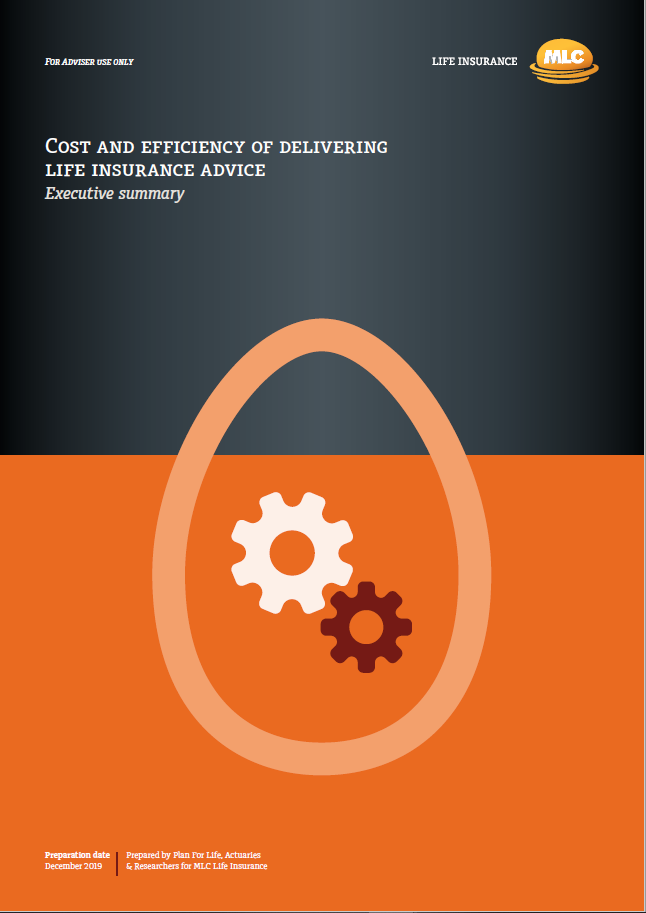A new white paper commissioned by MLC Life Insurance has delivered a detailed and sobering assessment that contrasts the cost of delivering life insurance advice and the remuneration advisers receive.
 While some of the headline numbers clearly demonstrate the challenges facing commission-only advice propositions in particular, the report concludes Australia’s life insurance advice industry has arrived at a watershed moment, and maps out a set of recommendations intended to address and overcome the challenges outlined in its findings.
While some of the headline numbers clearly demonstrate the challenges facing commission-only advice propositions in particular, the report concludes Australia’s life insurance advice industry has arrived at a watershed moment, and maps out a set of recommendations intended to address and overcome the challenges outlined in its findings.
…Australia’s life insurance advice industry has arrived at a watershed moment
The white paper: Cost and efficiency of delivering life insurance advice, was prepared by research firm, Plan For Life. It explores the various components of the advice process as it applies to both new and existing clients and outlines the time and costs associated with each of the advice process components.
In overlaying advisers’ remuneration on the averaged cost of delivering their advice, the paper concludes that advisers who rely only on life insurance commissions will make a loss under the Life Insurance Framework remuneration reforms which will apply from 1 January 2020.
In concluding that relying on commission alone is unlikely to cover the cost of advice, the research confirmed the logical finding that as the complexity of a client’s insurance needs increases there is a corresponding increase in the cost of providing that advice. Those increased costs relate to the amount of time and extent of the adviser’s experience required, along with the nature of the policy solutions normally required.
The following table, taken from the whitepaper, sets out the researcher’s finding that commission-only advisers will make a loss at every point along the spectrum framed by simple policy advice at the ‘bottom end’ and complex policy solutions at the top:

Given the outcome of this commission and cost analysis, the whitepaper suggests that commission-only advisers may need to reduce their expenses by as much as 20-25 percent to return to profitability.
If this cost gap is not addressed, the report suggests risk advisers may need to commence charging their clients a fee in addition to commissions received from product issuers to remain sustainable.
Sean McCormack, Chief of Group and Retail Partners, MLC Life Insurance, noted “What is clear from the research is that there is a need for more detailed knowledge of the true operating costs associated with providing advice, and how each facet of the process – such as marketing, administration, client servicing and compliance, can impact overall profitability.”
McCormak emphasised that with upfront commissions reducing further next year, ”…it is imperative that advisers act.”
…it is imperative that advisers act
He said the whitepaper analysis shows impacted advisers should take the opportunity to better understand ‘peer relative industry averages’ and use this information to review their own business’ costs and, potentially, make changes to their business model.
Other key findings revealed in the whitepaper include:
- On average, a total of ten hours is required by a risk adviser to prepare and implement life insurance advice for a client in simple cases, and up to 15 hours for more complex cases
- Life insurers must do more to improve the efficiency of the advice process, by simplifying and speeding up the policy application and underwriting process
- While 67% of risk advisers say they have experienced a reduction in profit since the introduction of LIF in 2018, a surprising 42% say they haven’t made changes to their business model to accommodate the reduction
- Less than half (48%) of risk advisers said they felt they were ready for the next phase of the Life Insurance Framework remuneration reforms
- Advisers need to better understand their cost base
- Only 7% of adviser responses indicated they are charging clients for claims support despite the time and costs involved
…the status quo for risk advisers is unsustainable
The destination at which the whitepaper arrives after its journey through the life insurance advice process – taking into account the stark reality of the Life Insurance Framework remuneration reforms – is that the status quo for risk specialist advisers is virtually unsustainable.
In what may be an under-stated observation prefacing the report’s recommendations, PFL states the survey results point to numerous ways in which advisers could be assisted to meet the challenges of the new world of reduced commission and greater compliance. It says these solutions include business processes that are within advisers’ own control as well as those which fall within the life insurers’ sphere.
These are the whitepaper’s recommendations:
Advisers
Given the changing scenario created by the LIF commission changes, there is a clear need for advisers to look not only at new models for generating income, but also, to understand exactly what each aspect of their key processes are costing and identify where efficiency can be improved.
We would strongly recommend performing such a cost and efficiency review even where a revised fee-generating approach has already been established. Identifying the existing operational cost base so as to pinpoint where weaknesses in business functions reside, is a vital precursor to fixing them.
Specific areas of inefficiency identified, that could be fairly quickly addressed by the adviser include:
- Substantially increase the amount of time spent on lead generation and obtaining new clients
- Where possible, utilise communication technology such as Skype and Zoom to reduce the amount of time spent in travelling to external meetings
- Introduce better ways of recording client information, for example replacing manual methodology with much more efficient planning and administration software
- Delegate administrative work where possible, by virtual teams, virtual assistants
- Create a standard data format by using Jotform or Typeform, which could be sent to clients at renewal time to collect current needs and requirements, thereby reducing subsequent time and meetings
Insurers
There are several ways in which life insurers can assist advisers’ practices, which we would recommend as follows:
- Provide training in how to analyse business costs and efficiency, as well as ways to restructure fees within different business models
- Provide training on how to save costs by automation and use of technology
- Review the questions in the personal statement, determining ways in which these can be made shorter and easier to complete (while still being fit for purpose and managing risk)
- Review technology platforms and establish or improve Application Program Interface (API) Capability so that submitted data is entered into systems only once
- Analyse the life insurer’s processes, viewed from a client and adviser-centric point of view, with the aim of simplifying the requirements and shortening the durations
Click here to access an Executive Summary of the whitepaper report.
And click here to access the full whitepaper report.




So….insurance costs rise even though comms get halved, win for insurers. Less profit means in time, less advisers, so direct insurance sales, win for insurers. Clients pay higher premiums PLUS now additional adviser fees, win for who exactly? LIF, FSC, FASEA is a con. There is no positives for consumers anywhere I can see. Well done Libs you have created this cluster ****
The links are for the executive summary of the report only. I find the calculations shown there very simplistic with the costs going up at exactly the same pace as the premium.
I have done my own calculations and on the new upfront you can expect to be negative for the first 24 months with only making a profit from year 3 onwards, i.e. coming to similar conclusions. The current upfront is no worse than the previous hybrid but from next year on the reduction will remove all profit for the first two years.
Interesting article and further proof that the changes brought by LIF will have unintended consequences which are a monumental challenge. I suspect that many advisers will have calculated that their existing revenue base more or less covers the cost of running their business and if it doesn’t they are reducing expenses or investigating other business models which could provide synergies or economies of scale. New business may not be reliable as a means of sustaining the business. While the increase in ongoing may be helpful in the long run, you cannot help but feel these challenges coupled with changes to IP, education requirements and everything else coming our way, the industry is at a precarious point in history. It will only be the brave and resourceful that will survive.
It is exactly as you say, Tim. In time we may see how all this change pans out, but by then there will be no place for specialist life-risk advisers. How will the expected outcome address our under-insurance problem?
Hi Paul, thanks for your comment mate, as we both know, it doesn’t. How can it be that so many of us can see where this is heading and yet the regulators and politicians need wait for a 100 page report.
There are none as blind as those who refuse to see…
Another assumption being made is that all clients retain their cover with the initial adviser for at least 2 years to make any profit. There are still advisers out there looking for a quick buck that replace everything that comes across their desk. In this instance the initial adviser would be well underwater and going backwards. To correct this and reign in the poor behaviors the re-writing adviser should be wearing the clawback – if it is in the best interest of the client then they ought to be charging a fee to cover any clawback or perhaps the replacement product new commission covers this.
Actually, the new adviser replacing the policy withint he first 2 years cops the claw back. I recently did a cancel and replace for a client due to the previous adviser not aligning the policy to the needs correctly. It resulted in a reduction in premiums and I found out the hard way that the new adviser cops the claw back. I thought I was doing the right thing by the client but ended up having to pay for it. Lesson learned.
Nothing new here. I’ve used the ‘robbing Peter to pay Paul’ strategy. Even at 70% I often didn’t cover my new business costs unless the premium was greater than $4,000. I’ve relied on my ongoing renewal income to keep me in ‘profit’. Even at 60% from Jan 20, and being 100% risk only adviser, one thing for sure is I’m not switching to fee for service. I guess my ‘profit’ level will dip, but at the end of the day I would need to lose 30%+ of my current renewal income before going into a financially negative position.
I feel for all the Riskies who didn’t have the timeframe or client growth opportunities over the past years/decades to create a reasonable renewal income base. It was only by using Hybrid commissions from 1993 to 2017 that sees me remaining ‘profitable’. At Upfront commission renewals of 10-11% I would already be going out of business.
A classic case of government intervention creating more problems than it solves. Well done. Now APRA have intervened and will impose capital requirements, so the death spiral continues. The industry really needs to address the lack of new business premiums, and consider winding back LIF or some other measure to get us out of this hole.
Wind back LIF
Those only doing risk advice only are now unsustainable, I saw this coming years ago which is why I made a wise decision and retired. Now life is bliss in retirement.
So ok, I’ve reluctantly made staff redundant and I’m moving to smaller premises & trust me when I say I’m efficient. My question is how can such a survey not include under the ‘Insurers’ heading, ‘Get LIF wound back to ensure we have people actively writing new business’.
‘We can’t afford it’, they say. The same companies that say they can’t afford to pay more than 60% in the first year are paying 3+ times that in their NZ operations. Go figure…
Yes, there may need to be premium adjustments but sooner or later an actuary is going to figure out that it doesn’t matter how ‘competitive’ you make your product, without well trained advisers overcoming the typical client’s procrastination, bias, poor prioritisation & general apathy towards getting properly insured, they will not put enough product in force to keep the pools profitable.
I’m anticipating my new business will fall by around 75% this year because I’d rather enjoy life than work for free. And yes, after 40 years at the pointy end I’m considering other opportunities.
Once specialists have finally had enough, they won’t be easily replaced. The new breed of advisers don’t seem too interested in doing the hard yards that insurance requires, especially when it isn’t profitable. Can the industry survive on 8 or 10 apps a year from planners who will only do insurance when they absolutely can’t avoid it?
Unless insurers want to see an industry bloodbath over the next few years, they need to make writing new business attractive again. Working properly, insurance is basically a well functioning Ponzi scheme with the premiums from new, healthy lives propping up the older claimants. Without that steady stream of new clients it will soon fall over & the numbers seem to be indicating the rot has already started to set in.
And the government needs to understand that the industry not only looks after a lot of people financially when they need it most, but also employs a huge number of people, many of whom soon will soon be inflating the unemployment numbers.
As emkay mentioned below, with insurers not paying as much in commission, it seems odd premiums haven’t reduced over the years, certainly no one, especially the client is winning, remind me someone.., what was the reason for starting this moronic change.?
Greedy banks, insurers and executives of the aforementioned is the reason you are looking for.
It seems Plan for Life and MLC are not aware that the stated 70% and 60% is a mirage.
At no point this year, has any adviser received 70%, as all and Sundry seem to
forget, that from the simple $1,500 premium, ( or more commonly, $125 per month
so people can budget ) there must be removed from the stated commission, policy
fee’s, modal loadings and Stamp Duty.
So a $7 per month policy fee, 8% modal loading and 5% Stamp Duty, brings the total down to around $103 per month x 60% = $742 or 49.5%.
Then deduct Licensee fees and you can start to see that the heralded commission that
advisers get, is starting to look a lot less.
Then from that amount, we must deduct the actual cost of providing advice.
It is encouraging that this white paper recognises, that advice practices face losses every time they attain a new client, though it is patently wrong to suggest that
advisers will need to charge clients a fee, the simple reason being, clients will only pay from 0 to a few hundred dollars for risk advice and Nil for admin fix-ups, delays and road blocks, that is an advisers lot when dealing with Life Companies
MLC mentions advisers will need to review their Business costs, which is fine, though unless we retrench staff and move our Business into a spare bedroom, it is a difficult task to reduce costs.
10 Hours to complete an average simple case, is wrong.
There are very few simple cases and I would suggest that 10 hours total = failing BID.
7% of advisers charging for claims service, suggests 93% of advisers who do not want to put their clients through more stress by taking money off them at their most vulnerable time.
The adviser improvements do not take into account what is the biggest issue facing
Life Insurance Companies and advisers, which is AA > Australian Apathy.
Life insurance advice is not like Tax advice, in that there is a captured and motivated market.
You cannot commoditise Life Insurance advice into hourly rate, like the legal and accounting world.
It has been stated many times and will never change. Life insurance advice and the products that go with that advice must be sold and a success fee, is the only viable model that works.
Insurers are not in a position to train advisers on how to achieve cost efficiencies and
better utilise technology, as they are struggling with that themselves.
If insurers want to improve an adviser’s ability to survive, then, as a start, bring sustainable pricing back that does not jack up premiums every 1-2 years, which is the main cause of lapses.
Make the necessary changes to vastly improve new business, administration and claims
processes, then take a long hard look at what, as a collective group, you have done, which has brought on the chaos we now live with.
Fair pick up Jeremy. It’s never been 80,70,60.
On monthly [and some half yearly] premiums there are modal loadings. IP, TPD & Trauma have stamp duty and there’s always the good old policy fee.
But no one outside of advisers knows or cares that we don’t get [from 1 Jan] 60% of the NET premium.
So if they have NOT expressed it as a net premium cost then the Commission Less Costs figures increases by 16.67% on monthly premiums [less on half yearly] to only the policy fee on death only cover paid yearly. But how many clients do we have on death only annual paid policies. Me? I have about 15% and of those they are ALL over 65!
The insurers are already feeling it. They are all clamouring around in desperation looking for the next bit of new business they can get their greedy little fingers on while at the same time pretending they are the advisers best buddy. I get a call nearly every week from half a dozen different BDMs asking what they can do to help me put new business through to them. I tell them I’m way too busy to do any new business as I’m swamped just retaining my existing clients due to their ever increasing premiums causing clients to want to cancel their policies each and every renewal. Well FSC, banks and insurers… all I can say is you reap what you sow.
Comments are closed.